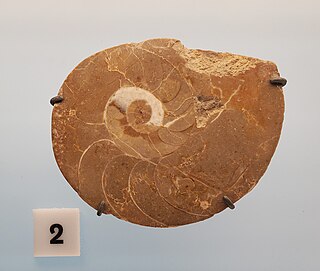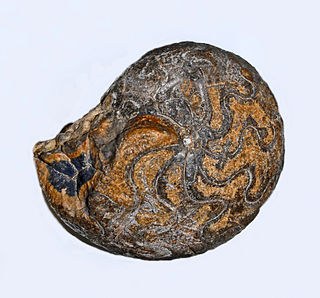
Goniatites is a genus of extinct cephalopods belonging to the family Goniatitidae, included in the superfamily Goniatitaceae. Hibernicoceras and Hypergoniatites are among related genera.
Symmetrocapulidae is an extinct taxonomic family of fossil snails, gastropod mollusks in the monotypic superfamily Symmetrocapuloidea within the clade Cycloneritimorpha.
Armatites is an Upper Devonian goniatitid included in the tornoceratid family. The shell, or conch, is discoidal, with flattened flanks, a flattened venter with a double keel, and a deep ventral sinus, but without ventrolateral grooves. The lateral saddle of the suture is broad. Armatites is known from the Upper Devonian (Fammenian) of Canning Basin in Australia. The subfamily in which it is included, the Aulatornoceratinae is also known from France with the genus Aulatornoceras.
Phenacoceratidae is one of three families of the superfamily Dimeroceratoidea. The family is placed in the order Goniatitida, and was first named by Rudolf Wedekind in 1918 who treated the group as a subfamily. The family was named for Phenacoceras, a junior synonym of Clymenoceras. They are an extinct group of ammonoids, which are shelled cephalopods related to squids, belemnites, octopodes, and cuttlefish, and more distantly to the nautiloids. They were fast-moving free-swimming (nektonic) carnivores.
Cheiloceratidae is a family of ammonoid cephalopods included in the goniatitid suborder Tornoceratina in which the suture has 4 to 12 lobes, the ventral one undivided and those in the lateral areas originating as subdivisions of internal and external lateral saddles.
Tornoceratoidea, also known as Tornocerataceae, is a superfamily of goniatitid ammonoids included in the suborder Tornoceratina. Tornoceratoidea, or Tornocerataceae, is essentially the Cheilocerataceae of Miller, Furnish, and Schindewolf (1957) in the Treatise Part L, revised to accommodate new taxa and new perspectives on the phylogeny.
The Posttornoceratidae are Late Devonian goniatites (Ammonoidea) included in the superfamily Tornoceratoidea. The family, Posttornoceratidae, named by Bogoslovsky in 1962, is based on the genus Posttornoceras, named by Wedekind in 1910, originally included in the Tornoceratidae.
Tornoceratidae is a family of goniatitid ammonoids from the middle and upper Devonian. The family is included in the suborder Tornoceratina and the superfamily Tornoceratoidea.
Aulatornoceratinae is one of three subfamilies of the goniatitid family Tornoceratidae, an extinct order of Paleozoic ammonoid cephalopods. Aulotornoceratinae was established as a subfamily by R.T.Becker, 1993, initially for Aulatornoceras, named by Schindewolf, 1922. Subsequently, four other genera have been added.

Prolecanitida is an order of extinct ammonoid cephalopods, the major Late Paleozoic group of ammonoids alongside the order Goniatitida. Prolecanitids had narrow shells, discoidal (disc-shaped) to thinly lenticular (lens-shaped). They retained a retrochoanitic siphuncle, a simple form with septal necks extending backwards. As is typical for ammonoids, the siphuncle sits along the ventral margin of the shell.

Mimagoniatites is a genus of ammonoid cephalopod which lived during the early Devonian, regarded as belonging to the Agoniatitdae as a member of the subfamily Mimagoniatitinae.

Clymeniida is an order of ammonoid cephalopods from the Upper Devonian characterized by having an unusual dorsal siphuncle. They measured about 4 cm (1.6 in) in diameter and are most common in Europe, North Africa, and South China but are known from North America and Australia as well.
Karagandoceratoidea is an Early Carboniferous (Mississippian) superfamily within the ammonoid order, Goniatitida, said to contain the Karagandoceratidae and Prodromitidae.
Pachylyroceras is a large, generally subglobular, Upper Mississippian gonitite and included in the cephalopod subclass Ammonoidea.
Lyrogoniatitites is a neoglyphioceratoidean ammonite, in the order Goniatitida, related to genera like Alaoceras, Cravenoceras, Dumbarigloria and Pachylyroceras.
Cravevoceras is an Upper Paleozoic ammonite in the goniatite family Cravenoceratidae, probably derived from Pachylyroceras and contemporary with other cravenoceratid genera like Caenolyroceras, Tympanoceras and later Alaoceras and Lyrogoniatites. It is also a member of the Neoglyphioceratoidea.
Raymondiceratinae is a subfamily of Upper Devonian cheiloceratid goniatites in which the sutures have 4 distinct lobes and the growth lines are convex. The subfamily includes three genera.

Kosmoclymeniidae is a family in the ammonoid order Clymeniida. They were fast-moving nektonic carnivores.

Beloceratidae is a family of ammonites included in the order Ceratitida.

Platyclymenia is a genus of ammonites belonging to the family Platyclymeniidae.







